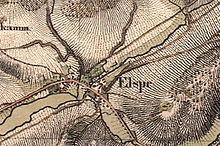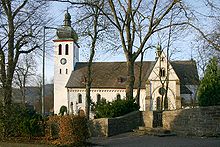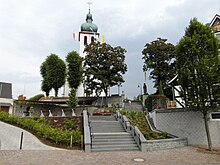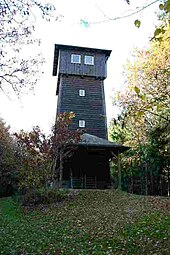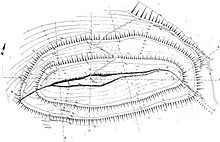Elspe
|
Elspe
City of Lennestadt
|
|
|---|---|
| Coordinates: 51 ° 9 ′ 15 ″ N , 8 ° 3 ′ 29 ″ E | |
| Height : | 269 m |
| Residents : | 2809 (Jun 30, 2020) |
| Incorporation : | 1st July 1969 |
| Postal code : | 57368 |
|
Elspe view of the town center, industrial settlements on the left, the arena of the Elspe Festival on the top right
|
|
Elspe is a village in the Sauerland with 2809 inhabitants at the end of June 2020 and a district of the city of Lennestadt . The proportion of 23.2% of residents over 65 years of age is comparatively higher than in the urban area of Lennestadt (17.4%).
The name Elspe can be traced back to the combination of the early forms "Alisa" and " apa ", which each point to the element water. The Latinized form of "Alisapa" is as "Elisopu" in a by Emperor Otto III. to find a document issued in AD 1000. According to a more recent study of the place names in the district of Olpe, the earlier terms mentioned can also be interpreted as “flowing water” or “water with alder trees”.
The village of Elspe is located in the Elspetal , framed by mountains up to a height of 550 m on the limestone reef of the Attendorn-Elsper double trough . Elspe became known nationwide through the Karl May Festival , in which Pierre Brice played for a while.
from history
Elspe was first mentioned in 1000 in a document that Emperor Otto III. to confirm the founding of the Oedingen Monastery . Elspe, along with Oedingen, is the oldest town in the Olpe district , to which the towns of Sporke , Hespecke , Melbecke , Obermelbecke, Trockenbrück, Theten and Hachen also belonged.
The farmers of Elspe
Free and unfree peasants with their inmates and sitters formed so-called peasant communities with the neighboring villages, headed by an elected village elder or village mayor or a peasant master. A new councilor was elected from each peasantry annually or every two years. Originally there were seven farmers (also called "Burskop") according to an income list from 1500. In 1683 the Förde and Bonzel farmers became their own parish, so that six farmers remained in Elspe:
- Elspe
- Oberelspe , Altenvalbert , Husen ( Elsperhusen ), upper Valbert , Rumpes Valbert wohe the noble house, undt Marpe
- Sporke , Hespecke , Nieder Melbicke and Ober Melbicke , item das Haus, which was incorporated into the noble Haus Borghausen
- Meggen , Halberbracht
- Burbecke , pegs and cams
- Thets and Hachen
The Elspe fire in 1805
On Trinity Sunday, June 9th, 1805, the center of Elspe burned down completely except for a few houses. According to tradition, a herding boy from Meister Peitts is said to have shot rats with a muzzle loader. The straw is said to have caught fire from the flames from the “thunder rifle”. In a short time the entire building was on fire. Contemporaries also cite other reasons for this conflagration.
With a strong westerly wind, the fire spread rapidly. The sparks wafted from the burning thatched roof of the house onto the thatched roofs of the neighboring buildings, so that the “Red Rooster” was looking for its victims there too. The fire roller spread out over the wider village with enormous force. Only 13 buildings in the southern part of the village in the direction of Elspebach were spared. What was still usable and usable was removed from the ruins.
The reconstruction of Elspe
The then mayor Schneider negotiated with the grand ducal authorities. They commissioned the Geometer Funke from Attendorn to plan the new village. This first determined the existence of the place and mapped it. In the new village, the houses should no longer be so close together because of the spread of the flames. For this reason, not all buildings could be placed on their old foundation walls and foundations. The previous round village of Elspe became a street village in which all the houses faced the street with gable ends. In order to obtain a larger village square and a straight street, the location of the houses was changed. The Bremkebach, which used to flow right through the property of today's Görg house, was moved into a new bed and straightened. The brook was piped in the street area.
Heidenstrasse along the church wall was widened and given a uniform gradient. The previously narrow passage between Bertels and Strucks was now easier to drive with multi-horse cars. The Salmeckebach, which previously ran along the street through the alley into the Elspe, has been relocated. The new, wide road through the village now led straight from the buildings under the church wall to the present-day Gasthof Börger house, then turned into the alley and ran parallel along the Elspebach in the direction of Trockenbrück on the old route.
After the fire, Elspe was transformed from a round village into a street village. It was not until the 1840s that the Provinzialstrasse was relocated from the Elspebach to the current route of the B 55 , so that the old route through the alley became a bypass.
Incorporation
The municipality of Elspe was incorporated into the new town of Lennestadt on July 1, 1969 .
In addition to the main town, the community brought a total of 18 other localities into the new town of Lennestadt. In addition to Altenvalbert, Burbecke and Elsperhusen, Elspe also included Ernestus, Germaniahütte, Hachen, Halberbracht, Hespecke, Meggen, Melbecke, Neukamp, Oberelspe, Obermelbecke as well as Sporke, Stöppel, Theten, Trockenbrück and Weißenstein.
Coat of arms of the municipality of Elspe
Divided by blue and silver, a plow above, mallets and irons crossed diagonally below in reversed colors.
- description
At the royal court in Elspe, Emperor Otto III confirmed. in the year 1000 the foundation of the monastery Oedingen. This makes Elspe the place in the Olpe district that has the oldest written mention. The Knights of Elspe, who had lived here since the 12th century, were owners of the Elspe-Hundem Vogtei, which was replaced by Kurköln around 1500. The colors of the coat of arms come from that of the bailiffs of Elspe . The figures indicate the economic peculiarity of the place, which was previously determined by agriculture and also shaped by mining. The coat of arms was approved on May 6, 1939.
Attractions
Church of St. James the Elder
The Roman Catholic parish church of St. Jakobus the Elder in Elspe is a Romanesque to early Gothic building. The Elspe miracle cross is located in the choir room .
Vitus Chapel
The Vitus Chapel was built in 1731 as a simple, small plastered building with narrow sides closed on three sides. It is covered with a natural slate roof and crowned by a roof turret.
Double cross
Not far from Elspe, near the village of Obermelbecke, there is one of the few double crosses in the Sauerland. According to a legend, a wedding carriage overturned at this point on the old church path from Obermelbecke in the direction of Elspe and buried the bride and groom coming from the church in Elspe. According to another story, two school children are said to have been struck by lightning there. According to the third variant of the legend, a Russian soldier is said to have died there in pursuit of Napoleon's defeated armies (F. Kaiser - An old church village in the Sauerland).
New village square Gellestatt
After the demolition of an old building (Haus Arens) in the immediate vicinity of the parish church, the opportunity arose to create a village square on the Gellestatt. The designation Gellestatt is intended to indicate that an early historical court was located at this point (what was spoken there was valid, was current law). In the design planning of the working group responsible for the local interests of the citizens (ARGE Elspe) in autumn 2011, not only specialist offices but also the residents of the square were included. An important aspect was the creation of a smooth transition from the village center to the higher church area. In addition to the staircase, step-free access to the parish church was created. The main area of the new square is characterized by a stage covered with a canvas for smaller open-air events. There is also comfortable seating in the stage area. Above this level, a quiet zone with a fountain, trees and benches was set up near a small tower. The fountain is decorated with sculptures created by a well-known artist couple. During the construction phase, up to 30 volunteers took part in the work every day.
The completed facility was opened to the public on June 18, 2014 with great participation from the residents.
Wallburgturm
In 1937/38 a lookout tower was built on the summit of the 481 m high Weilenscheid, which was set on fire in the last days of the war. The remains of the foundations with the protruding steel girders shaped the image of Weilenscheid until 1997. According to an idea of the local SGV department Elspe, a new tower was built in 1997 in cooperation with the ARGE Elspe (working group for local matters) with the help of the Elsper population. 60 steps lead to the 14.50 m high observation tower, which is located within the Weilenscheid ramparts. The Weilenscheid can be accessed either from Elspe via the Vogelstange on the Humpolle, through the Burbecke or up from Hachen.
Wall system on the Weilenscheid
The Weilenscheid ramparts are located on the 481.4 m high Weilenscheid near Elspe .
regional customs
On Ascension Day, the local volunteer fire brigade invites you to the traditional fire brigade festival.
The St. Jakobus d. Ä. celebrates its traditional shooting festival every year on the 1st Sunday in August.
Elspe Festival
Elspe became famous for the Karl May Festival " Elspe Festival ", which has been taking place on the open-air stage there since 1958 , and which, thanks to guest stars such as Pierre Brice , drew large streams of visitors from beyond Germany to Elspe. The Karl May Festival is attended by around 200,000 spectators every year.
In 1993 the jazz artist Helge Schneider shot parts of his successful film Texas - Doc Snyder keeps the world in suspense on the stage of the Karl May Festival. One of the actors was Helmut Körschgen , producer and managing director of the Elspe Festival Jochen Bludau .
Personalities
Were born in Elspe
- Johannes Becker (1875–1955), politician
- Harry Blum (1944–2000), politician and former Lord Mayor of Cologne
- Peter Soemer (1832–1902), theologian and poet
Web links
- Website of the ARGE Elspe
- Elspe in the Westphalia Culture Atlas
Individual evidence
- ^ Information from the city of Lennestadt
- ↑ Elspe - Pictures, stories and history from a village in the Sauerland . Edited by Working group for local issues (association of Elsper associations). Fredeburg: Verlag Grobbel 1983. P. 9.
- ↑ see in detail Flöer, Michael, Die Ortsnames des Kreis Olpe, Westfälisches Ortsnamenbuch (WOB), Bielefeld: Verlag für Regionalgeschichte 2014, pp. 88,89
- ↑ The certificate is in the Werl City Archives . Cf. Jolk, Michael: “Habent sua fata diplomata”. The oldest document of the Soest district, issued under Emperor Otto III, is 1000 years old. In: Werl yesterday-today-tomorrow 2000th year book, ed. by the city of Werl and the New Home and History Association Werl eV, pp. 69–74.
- ↑ 200 years of the Elspe fire, Wolfgang Poguntke, 2005
- ↑ Martin Bünermann: The communities of the first reorganization program in North Rhine-Westphalia . Deutscher Gemeindeverlag, Cologne 1970, p. 90 .
- ^ Local law of the city of Lennestadt: List of localities
- ↑ s. also article: Gellestatt becomes an attractive village center , in: Westfalenpost, newspaper for Lennestadt and Kirchhundem, edition of February 7, 2014.
- ↑ s. In detail: Historical evening for the whole city , in: Westfalenpost, newspaper for Lennestadt and Kirchhundem, edition of June 21, 2014



